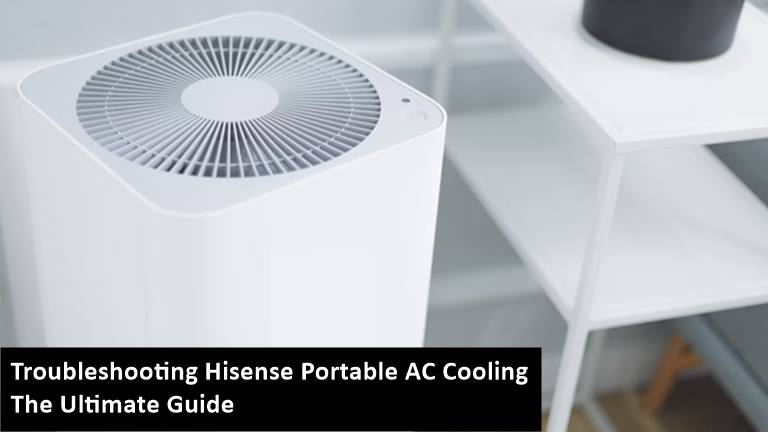Hello there! If you’ve found your way to this blog post, you’re probably dealing with a frustrating issue – your Hisense ac not cooling as it should. Don’t worry; you’re not alone. I’ve been there myself, and I understand the discomfort it can cause, especially on hot summer days.
In this guide, I’m going to share my personal experience and provide you with some valuable insights about Hisense portable air conditioner troubleshooting. More importantly, I’ll walk you through the steps to troubleshoot and fix the issue right at home.
Let’s dive in and get your portable air conditioner back to keeping your space comfortably cool.
Understanding Hisense Portable Air Conditioner
Before we delve into hisense air conditioner troubleshooting and fixing process, let’s take a moment to understand how your Hisense portable air conditioner works. Knowing the basics will make it easier to identify the issues and apply the right solutions.
How Hisense Portable AC works
A Hisense portable air conditioner operates by drawing warm indoor air through a series of cooling coils. These coils contain a refrigerant that absorbs heat from the air, cooling it down. The air is then circulated back into the room while the warm air is expelled through the exhaust hose.
Key Components
Cooling Coils: These are responsible for absorbing heat from the air.
Refrigerant: It’s the substance that circulates through the coils, facilitating the cooling process.
Fan: The fan helps in the circulation of cool air throughout the room.
Exhaust Hose: This expels the warm air outside your space.
Control Panel: Where you set the temperature and fan speed.
Understanding these components is essential because when your Hisense portable AC is not cooling the room, one or more of these components might be the culprit. Let’s move on to identify the common issues and their fixes.
Common Issues with Hisense Portable Air Conditioner Not Cooling
Now, let’s get into the nitty-gritty of the most common issues you might encounter when your Hisense portable ac is not cooling as expected. Identifying the specific problem is the first step toward finding the right solution.
Dirty Air Filter
Over time, the air filter in your portable air conditioner can get clogged with dust and debris. This restricts airflow and reduces cooling efficiency.
Improper Placement
Where you position your unit matters. If it’s too close to a wall or obstruction, it might not be able to draw in enough warm air to cool effectively.
Leaking Refrigerant
A refrigerant leak can seriously hamper the cooling process. You might notice a decrease in cooling performance if this is the issue.
Exhaust Hose Issues
A kinked or blocked exhaust hose can impede the flow of hot air, causing your unit to struggle with cooling.
Electronic Control Problems
Sometimes, electronic controls can malfunction, preventing your air conditioner from operating correctly.
Insufficient BTU Rating
Your portable air conditioner should be appropriately sized for the space you want to cool. If it’s too small for the room, it won’t cool effectively.
General Maintenance
Lack of regular cleaning and maintenance can lead to reduced performance over time.
Now that we’ve identified these common issues let’s move on to the steps you can take to diagnose and fix them. Remember, addressing the problem promptly can save you from discomfort and potentially expensive repairs.
Troubleshooting Hisense Portable Air Conditioner Not Cooling
Check the Air Filter
- Turn off the unit and unplug it for safety.
- Locate the air filter behind the front grille.
- Remove the filter and inspect it for dirt and debris. If it’s dirty and blocking light, clean it following the manufacturer’s instructions or replace it if it’s damaged.
Verify Proper Placement
- Ensure that the air conditioner is placed at least 20 inches away from walls, curtains, or obstructions to allow proper air circulation.
- Confirm there’s enough space for airflow around the unit, ensuring that front and back vents are unobstructed.
Inspect the Exhaust Hose
- Examine the exhaust hose for kinks or obstructions that may restrict the flow of warm air.
- Straighten out kinks and ensure the hose is securely connected to both the unit and the window exhaust adapter.
- Confirm that the hose is vented to the outside, preventing warm air from re-entering the room.
Look for Refrigerant Leaks
- Inspect the unit and the surrounding area for signs of refrigerant leakage, such as oily spots or hissing sounds.
- If you suspect a refrigerant leak, do not attempt to repair it yourself. Contact a qualified technician to diagnose and fix the issue.
Test the Electronic Controls
- Ensure the thermostat is set to a lower temperature than the room’s current temperature.
- Test different modes (cooling, fan-only, etc.) for correct functionality, listening for unusual noises or clicking sounds.
Confirm BTU Rating
- Check the product manual or label on your portable air conditioner to confirm its BTU rating, indicating its cooling capacity.
- Compare this rating to the room size. If the BTU rating is too low for the room, cooling effectiveness may be compromised.
Perform General Maintenance
- Regularly clean coils, condenser, and evaporator fins following the manufacturer’s instructions.
- Use a soft brush or vacuum cleaner to remove dust and debris from coils, paying close attention to the evaporator (indoor) and condenser (outdoor) coils.
Check for Error Codes
- Some Hisense air conditioners have error codes that provide diagnostic information. Consult the user manual for guidance on interpreting these codes.
Inspect the Compressor
- Locate the compressor, typically at the back of the unit.
- Ensure the compressor runs when the air conditioner is on, indicated by warm air coming from the back. If not, it may indicate a compressor issue.
Evaluate the Condenser Coils
- Examine condenser coils for dirt or blockages that can hinder cooling.
- If needed, clean condenser coils using a coil cleaning solution or a soft brush, following manufacturer instructions.
Final Thoughts
In conclusion, hisense portable air conditioner troubleshooting can be a frustrating experience, especially during hot weather. However, armed with the knowledge gained from this guide, you can effectively troubleshoot and address many common issues right at home.
Remember to start with the basics: check the air filter, ensure proper placement, and inspect the exhaust hose. These simple steps can often resolve cooling problems. Additionally, regular maintenance, such as cleaning the coils and filters, goes a long way in maintaining optimal performance.
For more complex issues like refrigerant leaks, compressor problems, or electrical malfunctions, it’s wise to seek professional assistance. Attempting complicated repairs without the necessary expertise can lead to further damage.
By following the troubleshooting steps, seeking professional help when needed, and implementing preventive measures, you can enjoy a cool and comfortable living space throughout the hot seasons with your Hisense portable air conditioner. Stay cool!

Hello, I’m James, the founder of FixitAllSecure.com. With over 10 years of experience in appliance repair, I’ve made it my mission to assist homeowners like you in resolving appliance issues, saving you precious time and money. From practical repair guides to prevention tips, I’m here to ensure your appliances run smoothly and your household stays stress-free.

